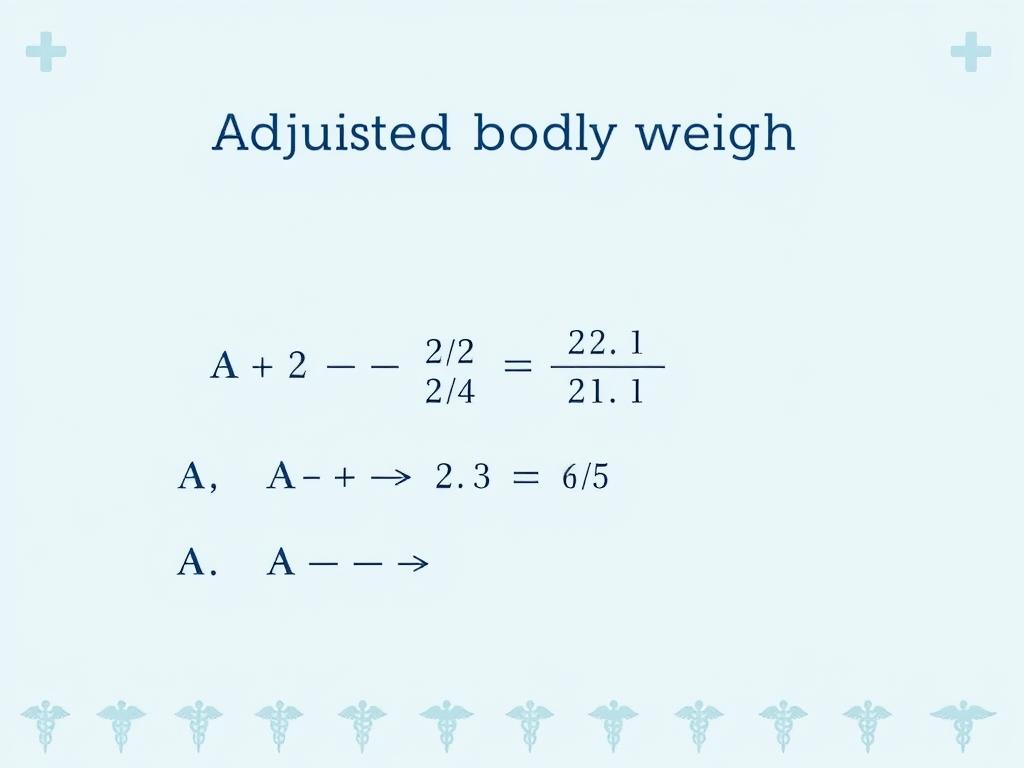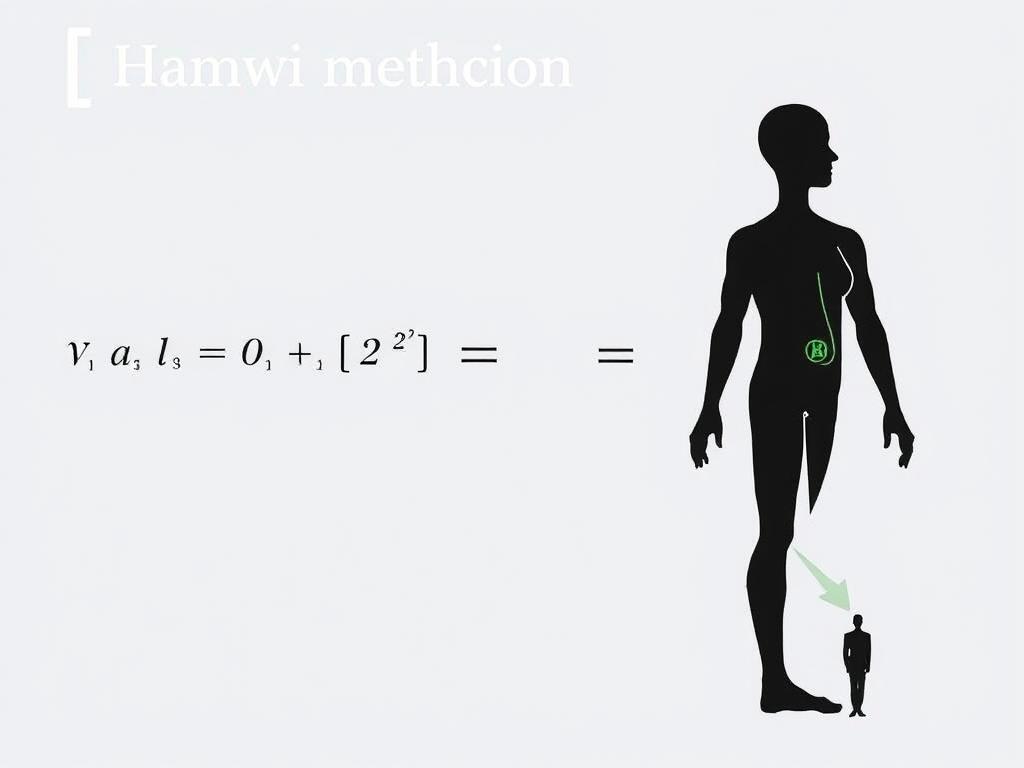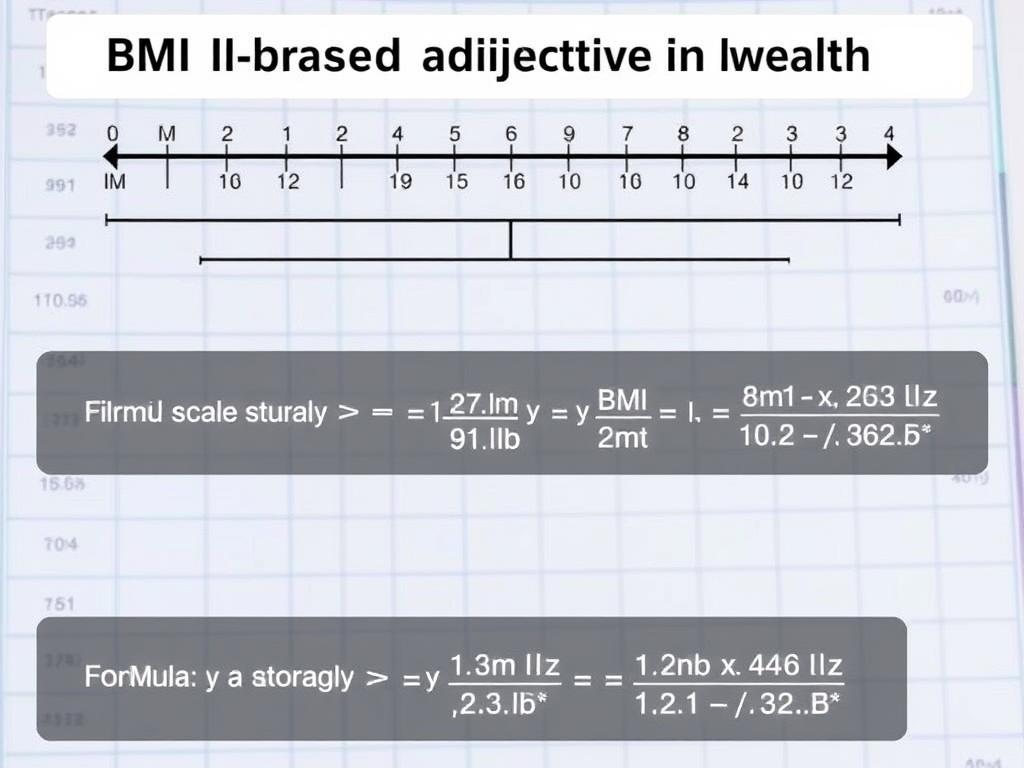Why Adjusted Body Weight Is Important in Obesity Management
When treating patients with obesity, using actual body weight for calculations can lead to inaccurate results. This happens because adipose (fat) tissue is less metabolically active than lean tissue and contributes differently to a person’s overall metabolism and drug distribution.
Adjusted body weight (AjBW) accounts for these differences by considering both ideal body weight and actual body weight. This provides a more balanced measurement that reflects the person’s metabolically active tissue, resulting in more appropriate medication dosing and nutritional planning.
The primary reasons healthcare professionals use adjusted body weight include:
- More accurate medication dosing to prevent overdosing or underdosing
- Better estimation of nutritional needs, especially protein requirements
- More precise calculation of renal function and drug clearance
- Improved assessment of metabolic rates and energy requirements
Need Quick Calculations?
Download our free adjusted body weight calculator to make accurate calculations for your patients or personal use.
3 Common Adjusted Body Weight Formulas for Obesity
Several formulas exist for calculating adjusted body weight, each with specific applications in clinical practice. Here are three widely used methods:
1. The Devine Formula (Modified)

The Devine formula first calculates ideal body weight (IBW) and then applies an adjustment factor:
For men: IBW (kg) = 50 kg + 2.3 kg × (height in inches – 60)
For women: IBW (kg) = 45.5 kg + 2.3 kg × (height in inches – 60)
Adjusted Body Weight: AjBW = IBW + 0.4 × (Actual Weight – IBW)
Example: For a man who is 5’10” (70 inches) tall and weighs 120 kg:
- IBW = 50 + 2.3 × (70 – 60) = 50 + 23 = 73 kg
- AjBW = 73 + 0.4 × (120 – 73) = 73 + 0.4 × 47 = 73 + 18.8 = 91.8 kg
2. The Hamwi Method

The Hamwi method uses a different approach to calculate ideal body weight before applying the adjustment:
For men: IBW (kg) = 48.0 kg + 2.7 kg × (height in inches – 60)
For women: IBW (kg) = 45.5 kg + 2.2 kg × (height in inches – 60)
Adjusted Body Weight: AjBW = IBW + 0.25 × (Actual Weight – IBW)
Example: For a woman who is 5’6″ (66 inches) tall and weighs 100 kg:
- IBW = 45.5 + 2.2 × (66 – 60) = 45.5 + 13.2 = 58.7 kg
- AjBW = 58.7 + 0.25 × (100 – 58.7) = 58.7 + 0.25 × 41.3 = 58.7 + 10.3 = 69 kg
3. BMI-Based Adjustment Method

This method uses body mass index (BMI) to determine ideal weight and then applies an adjustment:
Step 1: Calculate BMI = Weight (kg) / [Height (m)]²
Step 2: Calculate IBW = 25 × [Height (m)]² (using BMI of 25 as ideal)
Step 3: AjBW = IBW + 0.33 × (Actual Weight – IBW)
Example: For a person who is 1.75 m tall and weighs 110 kg:
- BMI = 110 / (1.75)² = 110 / 3.0625 = 35.9 kg/m²
- IBW = 25 × (1.75)² = 25 × 3.0625 = 76.6 kg
- AjBW = 76.6 + 0.33 × (110 – 76.6) = 76.6 + 0.33 × 33.4 = 76.6 + 11 = 87.6 kg
Need These Formulas for Reference?
Get our printable formula sheet with all calculation methods and examples for quick reference in clinical settings.
Comparison of Adjusted Body Weight Methods
Different calculation methods may be more appropriate depending on the clinical context. The following table compares the three common methods:
| Method | Formula | Use Case |
| Devine (Modified) | IBW + 0.4 × (Actual Weight – IBW) | Medication dosing, especially for antibiotics and chemotherapy |
| Hamwi | IBW + 0.25 × (Actual Weight – IBW) | Nutritional assessments and protein requirements |
| BMI-Based | IBW + 0.33 × (Actual Weight – IBW) | General clinical assessments and research settings |
The adjustment factors (0.4, 0.25, and 0.33) reflect different assumptions about how excess weight contributes to metabolic activity and drug distribution. The Devine method with 0.4 assumes a higher proportion of metabolically active tissue in excess weight, while the Hamwi method with 0.25 is more conservative.
Step-by-Step Calculation Walkthrough

Let’s walk through a complete example of calculating adjusted body weight using the Devine formula for a sample patient:
Patient Profile:
- Gender: Female
- Height: 5’4″ (64 inches)
- Actual Weight: 95 kg
Step 1: Calculate Ideal Body Weight (IBW)
Using the Devine formula for women:
IBW = 45.5 kg + 2.3 kg × (height in inches – 60)
IBW = 45.5 kg + 2.3 kg × (64 – 60)
IBW = 45.5 kg + 2.3 kg × 4
IBW = 45.5 kg + 9.2 kg
IBW = 54.7 kg
Step 2: Calculate the Difference Between Actual and Ideal Weight
Weight Difference = Actual Weight – IBW
Weight Difference = 95 kg – 54.7 kg
Weight Difference = 40.3 kg
Step 3: Apply the Adjustment Factor
Using the 0.4 adjustment factor from the Devine method:
Adjustment = 0.4 × Weight Difference
Adjustment = 0.4 × 40.3 kg
Adjustment = 16.12 kg
Step 4: Calculate the Adjusted Body Weight
AjBW = IBW + Adjustment
AjBW = 54.7 kg + 16.12 kg
AjBW = 70.82 kg
Therefore, for this patient, the adjusted body weight is 70.82 kg, which would be used for medication dosing and nutritional calculations instead of the actual weight of 95 kg.
Clinical Applications of Adjusted Body Weight

Adjusted body weight calculations have several important applications in clinical practice:
1. Medication Dosing
Many medications distribute differently in adipose tissue versus lean body mass. Using adjusted body weight helps prevent:
- Overdosing of medications that poorly penetrate adipose tissue
- Underdosing of medications that require weight-based calculations
- Toxicity from drugs with narrow therapeutic windows
Medications commonly dosed using adjusted body weight include certain antibiotics (e.g., vancomycin), chemotherapy agents, and anesthetics.
2. Nutrition Planning
Adjusted body weight helps dietitians and nutritionists:
- Calculate appropriate caloric needs for weight management
- Determine protein requirements more accurately
- Design more effective nutritional interventions
- Set realistic weight loss goals
3. Renal Function Assessment
Kidney function tests and medication adjustments for patients with renal impairment often use adjusted body weight in formulas such as:
- Cockcroft-Gault equation for creatinine clearance
- Dosing adjustments for renally cleared medications
- Dialysis prescription calculations
Need Clinical Guidance?
Our team of specialists can provide personalized consultation on implementing adjusted body weight calculations in your clinical practice.
Limitations of Adjusted Body Weight Calculations

While adjusted body weight calculations are valuable clinical tools, they have several important limitations to consider:
Limitations of Adjusted Body Weight
- Not universally applicable: Some medications and clinical situations require actual body weight or ideal body weight instead.
- Variation between formulas: Different adjustment factors (0.25, 0.33, 0.4) can yield significantly different results.
- Limited research validation: Not all formulas have been extensively validated across diverse populations.
- Does not account for body composition: Doesn’t directly measure lean vs. fat mass; only estimates based on height and weight.
- May not apply to athletes: Individuals with high muscle mass may be misclassified.
- Not appropriate for pregnancy: Special considerations apply for pregnant patients.
- Age considerations: Most formulas don’t account for age-related changes in body composition.
Healthcare professionals should use clinical judgment alongside these calculations and consider individual patient factors. In some cases, more direct measurements of body composition (such as bioelectrical impedance analysis or DEXA scans) may be warranted for critical clinical decisions.
Key Takeaways for Healthcare Professionals

- Adjusted body weight provides a more accurate basis for clinical calculations in patients with obesity compared to actual body weight.
- Multiple formulas exist (Devine, Hamwi, BMI-based); select the appropriate one based on your clinical context and institutional guidelines.
- Document clearly which method was used for calculations to ensure consistency in patient care.
- Consider individual patient factors that might affect the applicability of adjusted body weight calculations.
- Use adjusted body weight primarily for medication dosing, nutritional assessments, and renal function calculations.
- Recognize the limitations of these calculations and supplement with clinical judgment.
- Stay updated on institutional protocols and research regarding adjusted body weight applications.
Stay Updated on Clinical Calculations
Subscribe to our newsletter for the latest research and guidelines on adjusted body weight calculations and other clinical tools.
Conclusion
Calculating adjusted body weight is an essential skill for healthcare professionals working with patients who have obesity. By accounting for the different metabolic activity of excess adipose tissue, adjusted body weight provides a more accurate basis for medication dosing, nutritional planning, and other clinical calculations.
While several formulas exist, the choice of method should be guided by clinical context, institutional protocols, and the specific application. Healthcare professionals should understand both the utility and limitations of these calculations, using them as tools to enhance clinical decision-making rather than as absolute determinants.
By implementing adjusted body weight calculations appropriately, clinicians can provide more precise, effective, and safer care for patients with obesity, ultimately improving clinical outcomes and patient safety.
Frequently Asked Questions
When should I use adjusted body weight instead of actual body weight?
Use adjusted body weight when calculating doses for medications that don’t distribute well into adipose tissue, when determining nutritional requirements for patients with obesity, and when calculating renal function using formulas like Cockcroft-Gault. Always check specific medication guidelines and institutional protocols.
Which adjustment factor (0.25, 0.33, or 0.4) should I use?
The choice depends on your clinical context and institutional guidelines. The 0.4 factor (Devine) is commonly used for medication dosing, 0.25 (Hamwi) for nutritional calculations, and 0.33 (BMI-based) for general clinical assessments. Check medication-specific guidelines and local protocols.
Can adjusted body weight be used for all medications?
No. Some medications require actual body weight (e.g., some low molecular weight heparins), while others use ideal body weight. Always check medication-specific dosing guidelines. When in doubt, consult with a clinical pharmacist.
Is adjusted body weight applicable to children with obesity?
Most adjusted body weight formulas were developed for adults. Pediatric dosing often uses different approaches. Consult pediatric-specific guidelines and consider consulting with pediatric specialists for complex cases.

